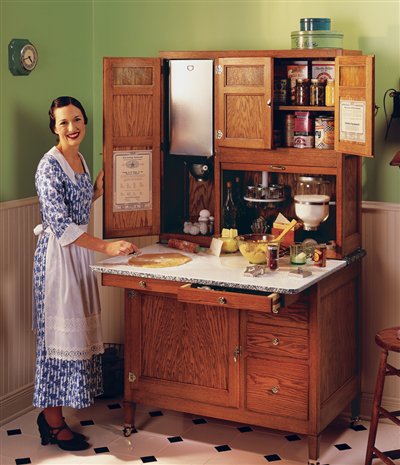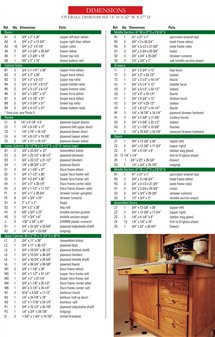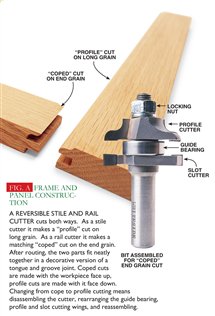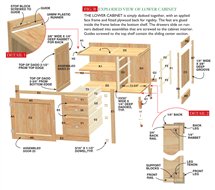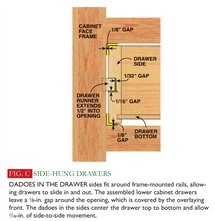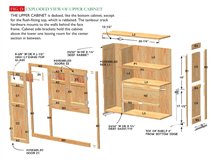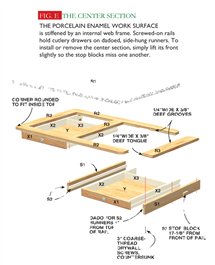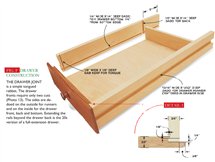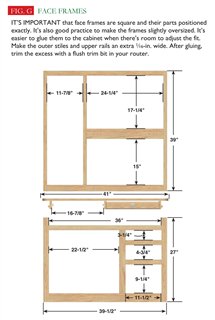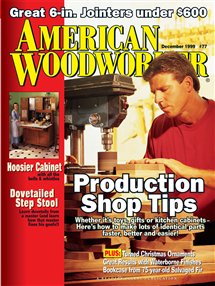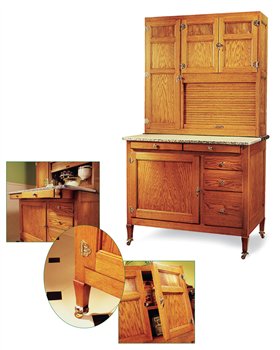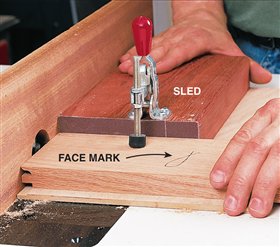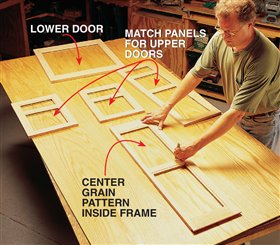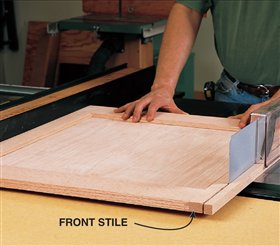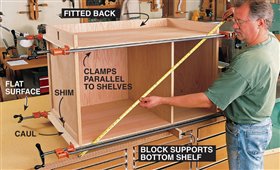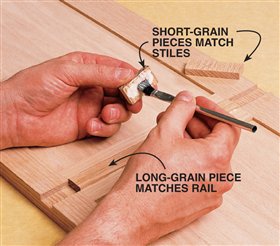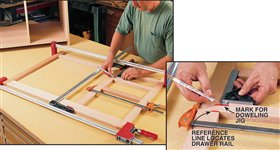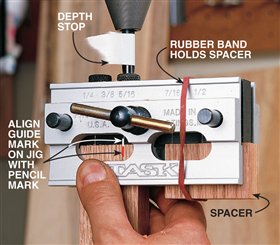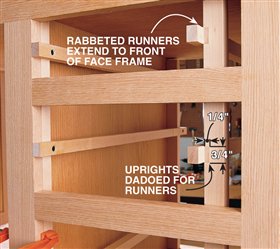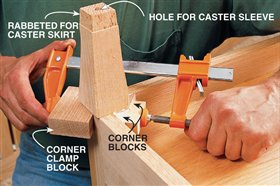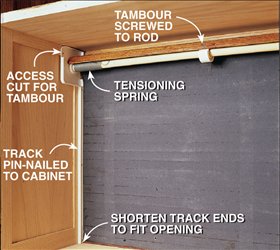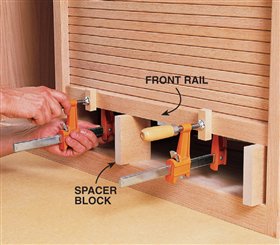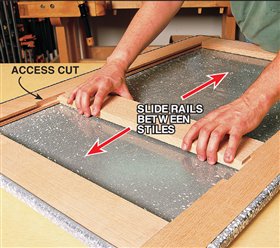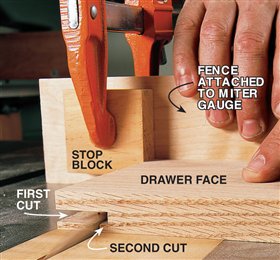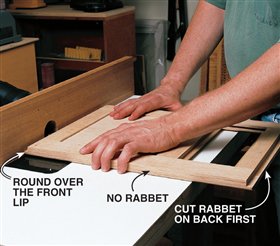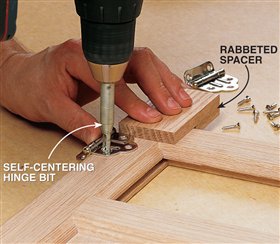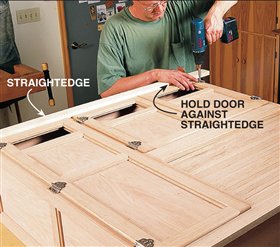Why
not put a Hoosier in your kitchen?Use it as a bread making center, a coffee bar, or to store dishes and linens or pots and pans. It’s still perfectly suited to today’s modern kitchens.
This Hoosier is loaded with useful features. The center section slides in and out to maximize the usefulness of the porcelain enamel work surface. Two drawers are mounted under the work surface and slide with it, so their contents are always within reach. A tambour door provides access to the cabinet without the nuisance of swinging doors.
Although it’s a big project with many pieces, this Hoosier cabinet is not hard to build. It’s made from dimensional3⁄4-in.-thick wood. The cabinet joinery is simple, using dadoes, dowels and rabbets.The doors and cabinet sides are made with routed stiles and rails. The drawers are done on the tablesaw, and both the drawers and doors overlay the openings, so fitting them is a breeze. All the hardware surface mounts and you can buy the tambour ready to install!
You’ll need a dado set for your tablesaw, a router,router table,and bits (stile and rail, round-over, and flush trim), a doweling jig and a drill. A jointer and planer are handy, but optional.
For materials, you need 40 board feet of oak, one and one-half sheets of 3⁄4-in. A-1grade oak plywood, two sheets of 1⁄4-in.A-1 grade oak fiber core plywood, and 15 board feet of 4/4 birch for drawer sides and runners—not bad for such a large piece. All the hardware, from the porcelain enamel top to the “ant traps” is available from companies that specialize in the restoration of antique Hoosiers (see Sources, below). Your cost will be about $475 for lumber and $300 for the tambour system and cabinet hardware. If you want to dress up the interior, as we did, with internal bins and canisters, you’ll spend another $200.
Straight grain looks best
Give a sense of order to the
cabinet’s structure by using
straight-grained material for all
face, door and side frame pieces.
Cut straight-grained stock from
the edges of plain-sawn boards
or buy rift-sawn oak (about $50
extra). Either way, it’s worth the
effort.
Make the doors and cabinet sides first
It may seem odd to make doors
before the cabinets are done,
but it’s a good idea. The doors are the first thing you see, so
they should get the best-looking
panels (Photo 2). Besides, they’re
lipped doors that overlay their
openings, so an exact fit isn’t
critical.
Cut all of the door and side
frame stiles and rails (A1 – A6 and
B1 – B9) at the same time. Use flat
stock. Bowed or twisted pieces
will make your life miserable.
Make these pieces into frames
for the doors and sides using stile
and rail cutters (see Sources, below) mounted in your router table.
A reversible cutter set (Fig. A)
won’t break your budget ($40 to $85) and making the change
from one cut to the other only
takes a few minutes. Make coped
cuts (Photo 1), then rearrange the
cutters for the profile cuts.
Assemble the routed frames
and find panels (C1 – C5). Finally,
glue the parts together into doors
(Z1, Z2 and Z5) and cabinet sides
(D1 and L1).
Build the two cabinets
The upper and lower cabinets
share joinery methods and have
similar components. Make one
and you’ll have no trouble with
the other.
Build the lower cabinet first (Fig.
B). After making the sides (D1) and
cutting them to width (Photo 3),
square one end with a router and
straightedge, then cut the other
to finish length on the tablesaw.
Make the top and bottom rails
an extra 1⁄8-in. wide and the stiles
an extra 1⁄4-in. long so you’ll have
plenty of extra height to square
the sides. After the sides are cut to
size, cut rabbets in the back stiles
for the plywood back. Cut the plywood
shelves (D2) and divider D3).
Then cut dadoes for them, after
using scrap stock to set the depth
and width. Fit the plywood back
(D4) and then assemble the lower
cabinet (Photo 4).
The upper cabinet (Fig. D) is
similar to the lower cabinet, but
has a middle half-width shelf (L5),
which requires extra dadoes. It
also has a rabbet for the top shelf
(L2) instead of a dado. It’s easier to
glue this cabinet together in two
stages. Keep the top shelf in place
but unglued while gluing up everything else and glue it separately later.
Face frames (E1 – E5 and M1 – M5)
give the cabinets strength and a clean
appearance (Fig. G). Doweling jigs (see
Sources, below) make assembly fast and
accurate (Photos 5 and 6). You’ll need
cauls and at least a dozen clamps with
30-in. capacity to glue the face frames on the bottom cabinet and even more
for the top. Or you can use a nail gun
and glue and nail the face frames to
the cabinet. After gluing, ease the side,
top and tambour opening edges with
a 1⁄4-in. round-over bit.
Finish the lower cabinet
Install drawer runner assemblies in the
lower cabinet. They fit behind the face
frame so only the runners protrude
into the drawer openings (Photo 7).
Make the birch uprights (F1) first. They
fit against the divider on the left and
the cabinet side on the right. To locate
the positions of the runners (F2), set
one of the uprights in place behind
the face frame and mark it for dadoes centered in each drawer opening. Use
this piece to set up and cut the dadoes
in all four pieces. Mill the runners from
straight-grained birch stock so they’re
flat and square. Cut rabbets in their
front edges so they’ll extend beyond
the uprights to the front of the face
frame. Then screw them in place.
The legs (G1) have long tenons for
gluing behind the cabinet frame (Fig.
B, detail 2). With the cabinet upside
down, fit the tenons to the front inside
corners of the cabinet, making sure the
leg shoulders butt solidly against its
bottom edges. Then glue them
in place. Glue a rail (G2) to
the back edge of the
bottom shelf for the
back legs, rabbeted so it fits between
the leg tenon and cabinet back. After
gluing, add corner blocks (Photo 8).
Then drill holes in the legs and insert the
caster sleeves.
Turn the cabinet upright. Add guides
(H1), stops (H2) and ultra-high molecular
weight (UHMW) plastic strips (J) (see
Sources, p. 63) for the sliding center
section in the cavity at the top of the
cabinet (Fig. B, detail 1). Make sure the
guides are perpendicular to the cabinet
front and flush with the inside edge of
the face frame stiles.
Install the tambour in
the upper cabinet
Adapting a dedicated tambour and
track system made for a kitchen “appliance
garage” (see Sources, below) saves
the trouble of making a tambour and
routing tracks for it in the cabinet.
Instead, simply cut the plastic tracks
(N1) to fit the opening and make an
access slot in them for the tambour
(N2) (Photo 9). Cut the tambour to
width and then install the system following
the manufacturer’s instructions.
Make and attach the front rail (N3). Drill
holes through the bottom slats of the
tambour for fastening (Photo 10).
Assemble the center section
Cabinet side brackets (Q) (see Sources, below) hold the upper cabinet above the lower so the center section (Fig. E) has
room to fit between them. The center
section slides inside the cavity at the
top of the lower cabinet, limited by stop
blocks (H2 and S3) and the cabinet back.
The porcelain enamel work surface (R1)
fits neatly inside the concave curve of
the side bracket. It contains a web frame
for rigidity (Photo 11).
Three rails (S1) support the center
section and allow it to slide. The outer
rails, spaced 1⁄32-in. narrower than the
opening between the lower cabinet
stiles, limit side-to-side travel. Dadoed
runners (S2) in these rails hold narrow
drawers (Fig. E).
Cut dadoes in the rails and glue the
runners in them before drilling holes
for the mounting screws. Position the
rails 11⁄4-in. back from the front edge of
the porcelain enamel work surface to
allow a sufficient overhang once the
drawers are in place.
Make the drawers
All the drawers (parts T, U, V and X)
are side hung (Fig. C). Their joints are
made using simple tablesaw cuts (Fig.
F and Photo 13).
The cabinet drawer fronts are lipped
3⁄8 in. on all four sides so they overlay
the openings. The cutlery drawer fronts
have lipped edges, but are flush top
and bottom to maximize their depth.
Drill centered holes for the knobs
before gluing the drawers together.
Finish and mount the doors
Rabbet the backsides of the openings
at the top of the doors for the glass (see
Sources, below). Then create the 3⁄8-in.
lip on the door fronts by cutting a 3⁄8-in.
square rabbet around their back edges
(Photo 14). Test fit the offset hinges to
make sure the lip is the right thickness.
Put a door in its opening and lay a hinge
on it. If the lip is too thick, the hinge
won’t lay flat on the cabinet and the
door will bind. First mount the hinges
on the doors (Photo 15), then mount
the doors on the cabinet (Photo 16).
Apply a finish
This Hoosier is finished with a mediumbrown
colored, oil-based gel stain
topped with three coats of ambertoned
waterborne poly. Before using
them, I made double sure these
two different finish products
were compatible. First,
both were made by the same manufacturer. Second,
I read the labels, which verified
compatibility by name.
Gel stains are easy to apply and
color surfaces evenly. I used two
coats because I wanted a deep
color. Toning the poly warms the color
of the stained wood. Each coat
enhances the effect. It’s an easy way to get a nice looking, durable
finish.
Before finishing, remove all of
the hardware, sand everything
and remove the sanding dust.
Dampen the surfaces and sand
again, lightly, because the waterborne
finish will raise the grain,
even through the oil stain.
After letting the finish dry thoroughly,
mount the glass (Z3) in
the doors, reassemble your Hoosier,
and (have your spouse) start
baking.
Dimensions

Fig. A: Frame and Panel Construction

Fig. B: Exploded View of Lower Cabinet

Fig. C: Side-Hung Drawers

Fig. D: Exploded View of Upper Cabinet

Fig. E: The Center Section

Fig. F: Drawer Construction

Fig. G: Face Frames

Sources
(Note: Product availability and costs are subject to change since original publication date.)
Hardware Kits for this project are available from Phyllis Kennedy Hardware, Inc., 10655 Andrade Drive, Zionsville, IN 40677; 317-873-1316. Basic Kit contains porcelain enamel top, legs, slag glass, metal side brackets and cabinet hardware necessary to complete the cupboard; $235. (Does not include tambour and track system.)Add-on Kit contains flour bin (which is not food safe), sugar jar, spice jars and carousel and a door chart set; $200.
Hoosier Hardware and Accessories: Complete line available from Van ***’s Restorers Catalog; vandykes.com, 800-787-3355.
Frameless Track System with Tambour Door: Part # NPSW30 30 OW and NPST3; $62. Woodworker’s Hardware, PO Box 180 Sauk Rapids, MN 56379, 800-383-0130
Reversible Stile and Rail Cutters are widely available at home centers, woodworking specialty stores and through the mail. One mail-order source is MLCS, 800-533-9298, mclswoodworking.com; Item #8853; “Traditional” profile cutter set, 1⁄2-in. shank; $65; item #6553; ”Traditional profile cutter set, 1⁄4-in. shank; $65.
Doweling Jig, part #124315; $50 Hinge Bit, part #12808; $9 UHMW Adhesive-Backed Plastic, part #16L64; $6, Woodcraft Supply, woodcraft.com, 800-225-1153.
This story originally appeared in American Woodworker December 1999, issue #77.

December 1999, issue #77
Purchase this back issue. |
|
Click any image to view a larger version.


1. Make cope cuts in the end-grain of all of the rails first. A shop-made sled holds them safely in position while cutting. Glue a block of wood with one squarely cut end on top of a longer piece of
1⁄4-in. plywood. Screw on a toggle clamp. The sled assures a square cut and the block acts as a backer, preventing blow-out.

2. Be selective when choosing panels for the doors
and cabinet sides. Slide the frames around on the
plywood until you find attractive panels. Don’t
worry about wasting a little plywood. Locate panels
for the upper doors first. Then find panels for the
the lower door and cabinet sides.

3. Trim the cabinet sides to width and the front stiles to size at the same
time. Routing the narrow front stiles is dangerous. Instead, it’s good practice
(and faster) to make them the same width as the back stiles and cut away the
excess width after the side is glued up.

4. Keys to a successful, square glue-up. Work on a flat surface.
Keep the bottom shelf from sagging with a long support block under the
center divider. Slide the back into place. Align the cauls and clamps with
the dadoed shelves. A shim centered on the cauls distributes pressure
along the joint; apply even clamp pressure front and back. Measure
diagonals to check squareness. Have help. If you don’t have
help, use glue that has a long open time.
Oops!

I cut a dado in the wrong
place—an easy mistake to make.
If it happens to you, here’s a good
repair. Cut three pieces that fit the dado
and match the grain of the surrounding
areas. Plane them flush after gluing and
they’ll be almost unnoticeable.

5. Clamp the face frame pieces together
after positioning them carefully. Then, mark
them for doweling. Make sure the drawer rails
are properly spaced. Mark each joint for doweling.
One line drawn straight
across the joint marks both
pieces for the doweling jig. Label
both pieces of each joint so they
don’t get mixed up.

6. Drill holes for dowels. This doweling jig allows you to drill
two holes, even on narrow pieces,
from a single pencil mark. Clamp
the piece in a vise. When narrow
pieces have to be mounted off to
one side for drilling, a spacer block
evens clamp pressure. I like to
hold the jig while drilling to keep it
steady.

7. Birch runners in simple frames support
the side-hung drawers. The dadoed uprights
center the runners in the drawer openings.
Screw these frames to the back of the
face frame and to the inside walls at the
back of the cabinet.

8. Glue the leg to the lower cabinet. Then glue corner
blocks to the leg tenon and cabinet frame. These mail-order
legs (see Sources, below) are authentic Hoosier replicas,
ready for skirts and casters.

9. The tambour system is a snap to install. The
system works like a window shade, using spring
tension to help lift and roll the tambour,
which travels up and down in grooves in
the plastic tracks.

10. Clamp the front rail to the tambour and
attach it from the backside with screws. The
tambour and rail rest on spacer blocks that allow
room for the clamps.

11. Assemble the web frame inside the porcelain
enamel work surface. It fits inside the lip. Fit the
stiles first. They have access cuts in them so the rails
drop in place and slide into position.

12. Trim the tongue on the drawer front. First
cut a vertical slot, leaving 3⁄8-in. at the front (the
same thickness as the door lips) and 1⁄8-in. at the
back. Then cut the tongue to length.

13. Round the door edges with a 1⁄4-in. bit
after cutting rabbets around the backs. The two
adjacent edges of the small upper cabinet doors
(Z2) are not rabbeted.

14. Use a spacer to locate the door hinges and
drill centered holes for the screws. The hardware
comes with plated brass screws, which break easily.
Either use a steel screw to cut threads in the
holes first and lubricate the brass screws before
using them, or replace them altogether with stainless
steel screws.

15. Mount the doors on the cabinet, centered in the
openings. Their 3⁄8-in.-wide lips allow room for minor
adjustments. A straightedge clamped evenly across the
top of the cabinet aligns the door tops. |



